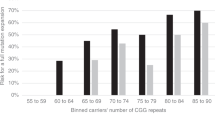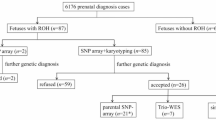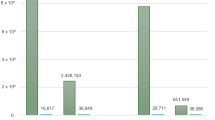Abstract
Regions of homozygosity (ROH) increase the risk of recessive disorders, and guidelines recommend reporting of excessive ROH in prenatal testing. However, ROH are common in populations that practice endogamy or consanguinity, and cutoffs for reporting ROH in such populations may not be evidence-based. We reviewed prenatal testing results (based on cytogenetic microarrays) from 2191 pregnancies in the Jewish and non-Jewish populations of Northern Israel and estimated the prevalence of ROH according to self-reported ethnicity and parental relationships. The proportion of the genome in ROH, ROH rate, was higher in non-Jews [Mean (SD) = 2.91% (3.92%); max = 25.54%; N = 689] than in Jews [Mean (SD) = 0.81% (0.49%); max = 3.93%; N = 1502]. In the non-Jewish populations, consanguineous marriages had the highest ROH rates [Mean (SD) = 7.14% (4.55%), N = 217], followed by endogamous [Mean (SD) = 1.13% (1.09%), N = 283] and non-endogamous [Mean (SD) = 0.69%(0. 56%), N = 189] marriages. ROH rates were greater than 5%, the ACMG-recommended cutoff, in 149/689 (21.63%) of the non-Jewish samples. Within the Jewish populations, the rates were similar between Ashkenazi, North African, and Middle Eastern Jews, but were higher for six consanguineous unions [Mean (SD) = 2.38% (1.23%)] and when spouses belonged to the same sub-population. Given the high ROH rates we observed in some subjects, we suggest that assessing the risk for recessive conditions in consanguineous/endogamous populations should be done before the first pregnancy, through genetic counseling and sequencing. Such an approach will: (1) identify couples who are at risk and counsel them on reproductive options; and (2) avoid the stress that couples who are not at risk may experience due to a prenatal ROH report.
This is a preview of subscription content, access via your institution
Access options
Subscribe to this journal
Receive 12 print issues and online access
269,00 € per year
only 22,42 € per issue
Buy this article
- Purchase on SpringerLink
- Instant access to full article PDF
Prices may be subject to local taxes which are calculated during checkout



Similar content being viewed by others
Data availability
The data that support the findings of this study are available from the corresponding author upon request.
References
Gonzales PR, Andersen EF, Brown TR, Horner VL, Horwitz J, Rehder CW, et al. Interpretation and reporting of large regions of homozygosity and suspected consanguinity/uniparental disomy, 2021 revision: a technical standard of the American College of Medical Genetics and Genomics (ACMG). Genet Med. 2022;24:255–61.
Pemberton TJ, Absher D, Feldman MW, Myers RM, Rosenberg NA, Li JZ. Genomic patterns of homozygosity in worldwide human populations. Am J Hum Genet. 2012;10:275–92.
Severson AL, Carmi S, Rosenberg NA. The effect of consanguinity on between-individual identity-by-descent sharing. Genetics. 2019;212:305–16.
Ceballos FC, Joshi PK, Clark DW, Ramsay M, Wilson JF. Runs of homozygosity: windows into population history and trait architecture. Nat Rev Genet. 2018;19:220–34.
Benn P. Uniparental disomy: origin, frequency, and clinical significance. Prenat Diagn. 2021;41:564–72.
Shalev SA. Characteristics of genetic diseases in consanguineous populations in the genomic era: lessons from Arab communities in North Israel. Clin Genet. 2019;95:3–9.
Wang JC, Ross L, Mahon LW, Owen R, Hemmat M, Wang BT, et al. Regions of homozygosity identified by oligonucleotide SNP arrays: evaluating the incidence and clinical utility. Eur J Hum Genet. 2015;23:663–71.
Alabdullatif MA, Al-Dhaibani MA, Khassawneh MY, El-Hattab AW. Chromosomal microarray in a highly consanguineous population: diagnostic yield, utility of regions of homozygosity, and novel mutations. Clin Genet. 2017;91:616–22.
Kang JTL, Goldberg A, Edge MD, Behar DM, Rosenberg NA. Consanguinity rates predict long runs of homozygosity in Jewish populations. Hum Hered. 2016;82:87–102.
McQuillan R, Leutenegger AL, Abdel-Rahman R, Franklin CS, Pericic M, Barac-Lauc L, et al. Runs of homozygosity in European populations. Am J Hum Genet. 2008;83:359–72.
Zidan J, Ben-Avraham D, Carmi S, Maray T, Friedman E, Atzmon G. Genotyping of geographically diverse Druze trios reveals substructure and a recent bottleneck. Eur J Hum Genet. 2015;23:1093–109.
Statistical Abstracts of Israel 2023-Israel in Figures – Rosh Hashana: Selected Annual Data 2023 (https://www.cbs.gov.il/he/mediarelease/DocLib/2023/298/11_23_298b.pdf) Central Bureau of Statistics Jerusalem.
Shalev SA, Zlotogora J, Shalata A, Levy-Lahad E. Medical genetics in Israel’s diverse population. Lancet. 2017;389:2453–55.
Zlotogora J, Patrinos GP, Meiner V. Ashkenazi Jewish genomic variants: integrating data from the Israeli National Genetic Database and gnomAD. Genet Med. 2018;20:867–71.
Ostrer H, Skorecki K. The population genetics of the Jewish people. Hum Genet. 2013;132:119–27.
Sharkia R, Tarabeia J, Zalan A, Atamany E, Athamna M, Allon-Shalev S. Factors affecting the utilization of genetic counseling services among Israeli Arab women. Prenat Diagn. 2015;35(4):370–5.
Na’amnih W, Romano-Zelekha O, Kabaha A, Rubin LP, Bilenko N, Jaber L, et al. Continuous decrease of consanguineous marriages among Arabs in Israel. Am J Hum Biol. 2015;27:94–8.
Tiwari HK, Beasley TM, George V, Allison DB. Multifactorial inheritance and complex diseases. In: Rimoin DL, Connor JM, Pyeritz RE, Korf BR, editors. Emery and Rimoin’s principles and practice of medical genetics. Philadelphia, PA: Elsevier Ltd.; 2007. p. 299–306.
Khayat M, Danial-Farran N, Chervinsky E, Zehavi Y, Peled-Peretz L, Gafni-Amsalem C, et al. The landscape of autosomal recessive variants in an isolated community: Implications for population screening for reproductive purposes. Clin Genet. 2021;100:522–28.
Waldman YY, Biddanda A, Davidson NR, Billing-Ross P, Dubrovsky M, Campbell CL, et al. The genetics of Bene Israel from India reveals both substantial Jewish and Indian ancestry. PLoS ONE. 2016;24:e0152056.
Ben-Yosef T, Banin E, Chervinsky E, Shalev SA, Leibu R, Mezer E, et al. Genetic causes of inherited retinal diseases among Israeli Jews of Ethiopian ancestry. Mol Vis. 2023;22:1–12.
Zlotogora J, Shalev SA. A long-term follow up of premarital counseling in the Israeli Arab population. J Community Genet. 2014;5(4):377–81.
Thain E, Shuman C, Miller K, Sappleton K, Myles-Reid D, Chitayat D, et al. Prenatal and preconception genetic counseling for consanguinity: Consanguineous couples’ expectations, experiences, and perspectives. J Genet Couns. 2019;28:982–92.
Acknowledgements
We want to express our gratitude to Professor Joel Zlotogora for his valuable notes and suggestions.
Author information
Authors and Affiliations
Contributions
Conceptualization: CGA, NV, MK, YT, and SAS; formal analysis: CGA, and SCP; methodology: CGA, NV, YT, OAZ, SC, and SAS; investigating: CGA, NV, YT, SC, and SAS; project administration: CGA, NV, MK, YT, OAZ, and SAS; supervision: SAS; validation: CGA, SC, OAZ, NV, MC, and SAS; writing—original draft: CGA; writing, review, and editing: CGA, SC, and SAS.
Corresponding author
Ethics declarations
Competing interests
The authors declare no competing interests.
Ethics approval and consent to participate
The study protocol was approved by the ethical committee of the Emek Medical Center, Afula, following the Helsinki Declaration. Research number EMC-0073-23. All procedures followed were in accordance with the ethical standards of the responsible committee on human experimentation (institutional and national) and with the Helsinki Declaration of 1975, as revised in 2000. This study used anonymized retrospective data, therefore consent forms were not required.
Additional information
Publisher’s note Springer Nature remains neutral with regard to jurisdictional claims in published maps and institutional affiliations.
Rights and permissions
Springer Nature or its licensor (e.g. a society or other partner) holds exclusive rights to this article under a publishing agreement with the author(s) or other rightsholder(s); author self-archiving of the accepted manuscript version of this article is solely governed by the terms of such publishing agreement and applicable law.
About this article
Cite this article
Gafni-Amsalem, C., Warwar, N., Khayat, M. et al. The distribution of regions of homozygosity (ROH) among consanguineous populations—implications for a routine genetic counseling service. J Hum Genet 70, 99–104 (2025). https://doi.org/10.1038/s10038-024-01303-z
Received:
Revised:
Accepted:
Published:
Issue Date:
DOI: https://doi.org/10.1038/s10038-024-01303-z



